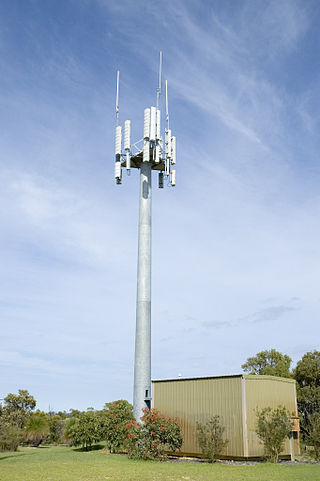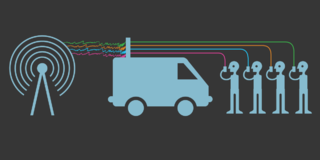Related Research Articles

Advanced Mobile Phone System (AMPS) was an analog mobile phone system standard originally developed by Bell Labs and later modified in a cooperative effort between Bell Labs and Motorola. It was officially introduced in the Americas on October 13, 1983, and was deployed in many other countries too, including Israel in 1986, Australia in 1987, Singapore in 1988, and Pakistan in 1990. It was the primary analog mobile phone system in North America through the 1980s and into the 2000s. As of February 18, 2008, carriers in the United States were no longer required to support AMPS and companies such as AT&T and Verizon Communications have discontinued this service permanently. AMPS was discontinued in Australia in September 2000, in India by October 2004, in Israel by January 2010, and Brazil by 2010.

Ultra high frequency (UHF) is the ITU designation for radio frequencies in the range between 300 megahertz (MHz) and 3 gigahertz (GHz), also known as the decimetre band as the wavelengths range from one meter to one tenth of a meter. Radio waves with frequencies above the UHF band fall into the super-high frequency (SHF) or microwave frequency range. Lower frequency signals fall into the VHF or lower bands. UHF radio waves propagate mainly by line of sight; they are blocked by hills and large buildings although the transmission through building walls is strong enough for indoor reception. They are used for television broadcasting, cell phones, satellite communication including GPS, personal radio services including Wi-Fi and Bluetooth, walkie-talkies, cordless phones, satellite phones, and numerous other applications.

A cell site, cell phone tower, cell base tower, or cellular base station is a cellular-enabled mobile device site where antennas and electronic communications equipment are placed to create a cell, or adjacent cells, in a cellular network. The raised structure typically supports antenna and one or more sets of transmitter/receivers transceivers, digital signal processors, control electronics, a GPS receiver for timing, primary and backup electrical power sources, and sheltering.

A cellular network or mobile network is a telecommunications network where the link to and from end nodes is wireless and the network is distributed over land areas called cells, each served by at least one fixed-location transceiver. These base stations provide the cell with the network coverage which can be used for transmission of voice, data, and other types of content. A cell typically uses a different set of frequencies from neighboring cells, to avoid interference and provide guaranteed service quality within each cell.

Mobile telephony is the provision of telephone services to mobile phones rather than fixed-location phones. Telephony is supposed to specifically point to a voice-only service or connection, though sometimes the line may blur.

The history of mobile phones covers mobile communication devices that connect wirelessly to the public switched telephone network.
In the U.S., Federal Communications Commission (FCC) regulations prohibit the use of mobile phones aboard aircraft in flight. Contrary to popular misconception, the Federal Aviation Administration (FAA) does not actually prohibit the use of personal electronic devices on aircraft. Paragraph (b)(5) of 14 CFR 91.21 permits airlines to determine if devices can be used in flight, allowing use of "any other portable electronic device that the operator of the aircraft has determined will not cause interference with the navigation or communication system of the aircraft on which it is to be used."

Mississippi State Penitentiary (MSP), also known as Parchman Farm, is a maximum-security prison farm located in the unincorporated community of Parchman in Sunflower County, Mississippi, in the Mississippi Delta region. Occupying about 28 square miles (73 km2) of land, Parchman is the only maximum security prison for men in the state of Mississippi, and is the state's oldest prison.

A mobile phone jammer or blocker is a device which deliberately transmits signals on the same radio frequencies as mobile phones, disrupting the communication between the phone and the cell-phone base station, effectively disabling mobile phones within the range of the jammer, preventing them from receiving signals and from transmitting them. Jammers can be used in practically any location, but are found primarily in places where a phone call would be particularly disruptive because silence is expected, such as entertainment venues.

A mobile phone signal is the signal strength received by a mobile phone from a cellular network. Depending on various factors, such as proximity to a tower, any obstructions such as buildings or trees, etc. this signal strength will vary. Most mobile devices use a set of bars of increasing height to display the approximate strength of this received signal to the mobile phone user. Traditionally five bars are used.
An inmate telephone system, also known as an Inmate Calling Service (ICS) or Inmate telephone service, is telephone service intended for use by inmates in correctional facilities in the United States. Telephone service for inmates allows for their rehabilitation by allowing consistent communication with their family and legal counsel while incarcerated.

The Metropolitan Detention Center, Guaynabo is a United States federal prison facility in Guaynabo, Puerto Rico which holds male and female inmates of all security levels who are awaiting trial or sentencing. It is operated by the Federal Bureau of Prisons, a division of the United States Department of Justice.

The StingRay is an IMSI-catcher, a cellular phone surveillance device, manufactured by Harris Corporation. Initially developed for the military and intelligence community, the StingRay and similar Harris devices are in widespread use by local and state law enforcement agencies across Canada, the United States, and in the United Kingdom. Stingray has also become a generic name to describe these kinds of devices.

Ajit Varadaraj Pai is an American lawyer who served as chairman of the Federal Communications Commission (FCC) from 2017 to 2021. He has been a partner at the private-equity firm Searchlight Capital since April 2021.
In most jurisdictions, prison inmates are forbidden from possessing mobile phones due to their ability to communicate with the outside world and other security issues. Mobile phones are one of the most smuggled items into prisons. They provide inmates the ability to make and receive unauthorized phone calls, send email and text messages, use social media, and follow news pertaining to their case, among other forbidden uses.
Internet use in prisons allows inmates to communicate with the outside world. Much like the use of telephones in prisons, the use of the internet under supervision, for various purposes, is approved in 49 U.S. correctional systems and five Canadian provinces. Each of the reporting U.S. systems, except Hawaii, Iowa, Nebraska and Nevada, use computers to employ inmate educational programs, as do all five reporting provinces in Canada. There are 36 reporting U.S. systems to handle inmate health issues via telemedicine. However much like the use of mobile phones in prison, internet access without supervision, via a smartphone, or personal laptop/iPad is banned for all inmates.

Cellphone surveillance may involve tracking, bugging, monitoring, eavesdropping, and recording conversations and text messages on mobile phones. It also encompasses the monitoring of people's movements, which can be tracked using mobile phone signals when phones are turned on.
A dirtbox is a cell site simulator, a phone device mimicking a cell phone tower, that creates a signal strong enough to cause nearby dormant mobile phones to switch to it. Mounted on aircraft, it has been used by the United States Marshals Service since at least 2007 to locate and collect information from cell phones believed to be connected with criminal activity. It can also be used to jam phones. The device's name comes from the company that developed it, Digital Receiver Technology, Inc. (DRT), owned by the Boeing company. Boeing describes the device as a hybrid of "jamming, managed access and detection". A similar device with a smaller range, the controversial StingRay phone tracker, has been widely used by U.S. federal entities, including the Federal Bureau of Investigation (FBI).

Securus Technologies is a technology communications firm serving department of corrections facilities and incarcerated individuals across the country. The company is a subsidiary of Aventiv Technologies. In the past, the company has faced criticism over phone call pricing, data security, monopoly and product innovation.
Robert Johnson is a retired South Carolina Department of Corrections Captain and United States Air Force veteran. He was a guard at the Lee Correctional Institution in South Carolina, where he oversaw efforts to stop contraband cellphones and drugs.
References
- 1 2 3 David Goldman (April 7, 2016). "FCC Wants to Stop Prisoners from Making Cell Phone Calls". CNN. Retrieved December 31, 2017.
- ↑ "NC Public Safety Secretary Erik Hooks Responds to Observer's Prison Investigation". The Charlotte Observer. June 9, 2017. Retrieved December 31, 2017.
- ↑ "Ala. DOC Focuses on Managed Access to Stop Contraband Cell Phones". CorrectionsOne. April 12, 2015. Retrieved December 31, 2017.
- ↑ Mike Cason (April 12, 2015). "Alabama Prisons Planning System to Block Inmate Cellphone Calls". AL.com. Retrieved December 31, 2017.
- 1 2 William Jackson (September 5, 2013). "Prisons Get a New Way to Stop Inmates From Using Cell Phones". GCN. Retrieved December 31, 2017.
- 1 2 "Managed Access Systems Can Prevent Contraband Cellphone Use". National Institute of Justice. July 31, 2017. Retrieved December 31, 2017.
- ↑ Willard Shepard (November 6, 2017). "Ex-Corrections Officer Works to Disconnect Inmates' Cell Phones". NBC Miami. Retrieved December 31, 2017.
- ↑ Carol McKinley (October 11, 2011). "Smartphones in Prison: New Contraband Allows Inmates to Make Money". The Daily Beast. Retrieved December 31, 2017.
- ↑ Ajit Pai; Nikki Haley (April 5, 2016). "Cellphones Are Too Dangerous for Prison: Nikki Haley and Ajit Pai". USA Today. Retrieved December 31, 2017.